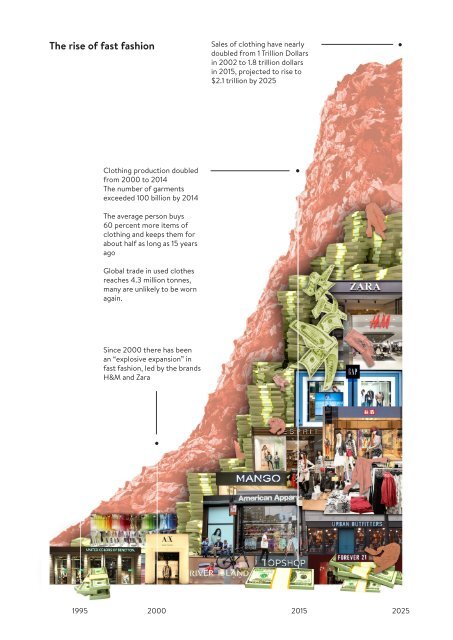Timeout for fast fashion
Fact-Sheet-Timeout-for-fast-fashion.pdf?utm_content=buffer5753a&utm_medium=social&utm_source=twitter
Fact-Sheet-Timeout-for-fast-fashion.pdf?utm_content=buffer5753a&utm_medium=social&utm_source=twitter
Create successful ePaper yourself
Turn your PDF publications into a flip-book with our unique Google optimized e-Paper software.
The rise of <strong>fast</strong> <strong>fashion</strong><br />
Sales of clothing have nearly<br />
doubled from 1 Trillion Dollars<br />
in 2002 to 1.8 trillion dollars<br />
in 2015, projected to rise to<br />
$2.1 trillion by 2025<br />
<strong>Timeout</strong> <strong>for</strong> <strong>fast</strong> <strong>fashion</strong><br />
Clothing production doubled<br />
from 2000 to 2014<br />
The number of garments<br />
exceeded 100 billion by 2014<br />
The average person buys<br />
60 percent more items of<br />
clothing and keeps them <strong>for</strong><br />
about half as long as 15 years<br />
ago<br />
Global trade in used clothes<br />
reaches 4.3 million tonnes,<br />
many are unlikely to be worn<br />
again.<br />
Since 2000 there has been<br />
an “explosive expansion” in<br />
<strong>fast</strong> <strong>fashion</strong>, led by the brands<br />
H&M and Zara<br />
The rise in the production and<br />
consumption of <strong>fast</strong> <strong>fashion</strong><br />
Fast, cheap <strong>fashion</strong> has changed the way we dress; it<br />
has also changed the way we think about clothes and<br />
what we do with them. We buy more clothes than<br />
ever be<strong>for</strong>e, we wear them fewer times - sometimes<br />
they are not worn at all - and while our wardrobes are<br />
cluttered with rarely used clothes, we are also treating<br />
clothes as disposable items. Fashion has become a<br />
novelty and the commercialisation and marketing of<br />
<strong>fashion</strong> is leading to overconsumption and materialism<br />
- keeping our clothes and cherishing them is not in<br />
<strong>fashion</strong> any more.<br />
Fashion retailers have been speeding up the turnaround<br />
of <strong>fashion</strong> trends since the 1980’s, increasing the rate<br />
that we use and throw away clothes – the life cycles of<br />
consumer products shortened by 50% between 1992<br />
and 2002. 1 But today’s <strong>fast</strong> <strong>fashion</strong> phenomenon really<br />
started at the turn of the century, with an even quicker<br />
turnaround of new styles achieved by brands like<br />
Zara and H&M, which have both shown an “explosive<br />
expansion” since 2000 to become the largest clothes<br />
retailers in the world. 2 The “<strong>fast</strong> <strong>fashion</strong>” promoted by<br />
these and other brands leads to increased consumption<br />
of all clothes, including budget and basic items. 3<br />
Rising sales, rising volumes<br />
The volume of clothes being consumed is increasing<br />
the impact of the textiles industry - already one of the<br />
biggest polluters. People in developed countries today<br />
own many more items of clothing than they can actually<br />
wear and with China and India following this dangerous<br />
trend, the absolute quantities of clothing consumed<br />
could rise even further.<br />
While in 2002 sales of clothing were worth $1 trillion,<br />
this has risen to $1.8 trillion by 2015 – and is <strong>for</strong>ecast<br />
to rise further to $2.1 trillion by 2025. 4 This represents<br />
huge volumes of material - clothing production doubled<br />
from 2000 to 2014. The average person buys 60<br />
percent more items of clothing and keeps them <strong>for</strong><br />
about half as long as 15 years ago. 5 It’s not surprising<br />
that this overconsumption is spread unevenly across the<br />
world; the average person in North America bought 16<br />
kg of new clothes in 2014 – the equivalent of 64 T-shirts<br />
or 16 pairs of jeans 6 – compared to only 2 kg per person<br />
in the Middle East/Africa. 7 People in China are already<br />
consuming 6.5 kg per person – above the global average<br />
of 5 kg/person – which could increase to anywhere<br />
between 11 and 16 kg per person by 2030. 8 Even if the<br />
amounts per person remain the same, increases in the<br />
population of countries such as China and India mean<br />
that the absolute quantities of clothing will continue to<br />
rise.<br />
The <strong>fast</strong> <strong>fashion</strong> trend is amplified by the <strong>fast</strong>er growth<br />
in sales of clothing online, which in the US is expected to<br />
grow at a rate of 17.2% in 2016 - 17. 9 China overtook the<br />
USA as the world’s largest digital market in 2014, with<br />
<strong>fashion</strong> the biggest e-commerce category. 10 The ease<br />
of shopping online <strong>for</strong> clothes is likely to increase the<br />
number of purchases made and fuel the turnover of <strong>fast</strong><br />
<strong>fashion</strong>. 11<br />
1995 2000 2015 2025<br />
02


